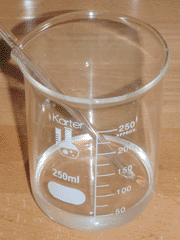
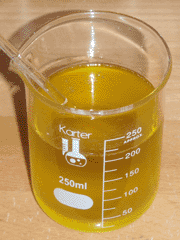
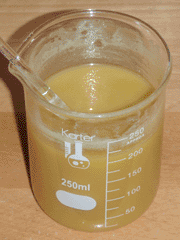
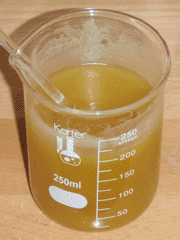
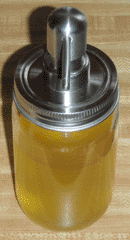
Throughout my experiments with oil and varnish, I regularly used solutions of potassium hydroxide to clean glassware. This forms a highly soluble soap (potassium resinate) with pine rosin, and saponifies linseed oil even after it has oxidized. Interestingly, the resulting solution often formed a lather when stirred, and generally left the glassware absolutely spotless. Since I have now completed my exploration of wood and metal coatings, I have decided to investigate soaps in more detail; however, linseed oil is unsuited for this purpose. As a drying oil, it is fairly reactive, and has a tendency to go rancid when used in soap. Olive oil, on the other hand, is the quintessential non-drying oil, and has been used to make soap for thousands of years.
To begin, I first added 30mL of water to a beaker, to which I added 30g of potassium hydroxide flakes, very slowly and pausing when necessary to avoid boiling. Once the flakes had dissolved and the solution had cooled to room temperature, I then added 150g of olive oil, which formed a layer on top of the water. I then stirred the mixture vigorously to form an emulsion, so that the two immiscible components could react with each other. The mixture slowly thickened, and after four hours of intermittent stirring (every 30 minutes until homogeneous), the emulsion had become thick enough to support itself, and the oil no longer had a tendency to separate out. I then left the mixture to react on its own, and over the next day it slowly became a transparent gel. I left it for a further day and there was no change, indicating that the reaction was complete. I verified this with a strip of pH paper; it gave a result of around 9, which is ideal for hand soap.
At this point the soap was usable in paste form, and was neither greasy nor drying, further indicating that the oil and alkali were properly balanced. It produced a small amount of lather, had a neutral smell, and was otherwise entirely usable as soap. However, I found the idea of paste soap to be somewhat unsanitary, so I decided to dilute it to a liquid for use with a pump dispenser. I added water to the paste in small increments over the course of two days, which slowly caused it to expand and become softer; however, it still retained its paste consistency and would not readily flow or pour. Ultimately, it took three parts of water (by volume) for every one part of paste to reach the desired consistency. I then added it to an ordinary pump dispenser, where it behaved identically to commercial liquid soap.
Overall, this process was straightforward and inexpensive, if somewhat tedious. The simple ratio of ingredients (1:1:5 by weight) is easy to remember, and the soap produced is useful and non-irritating. I will continue using this soap daily for hand-washing, and will also experiment with it in other contexts to determine its versatility.
The use of a handheld blender shortens this process significantly, forming a thick emulsion in less than a minute; however, this causes the subsequent reaction to be rapid and exothermic, so care must be taken when preparing larger batches. I have also found it advantageous to add a small amount of turpentine to the oil prior to blending (0.1% by weight, or 3 drops per 100g of oil). This adds a sweet pine scent to the soap, appears to improve its lathering properties, and may have additional benefits as a preservative and antiseptic. This improved soap is excellent for hand-washing, but I have also experimented with it on dishes and laundry, and it handles both of these tasks well. This soap has greatly simplified my collection of household cleaning materials, and at roughly $6 per gallon, it is considerably less expensive than the products it has replaced.
EDIT: 6/15/2025Since olive oil is currently very expensive, it is important to note that many other oils can be substituted to produce an equivalent soap. The exact properties of the soap, however, depend on the nature of the fatty acids within the oils being used. In general, the detergent power of the soap is determined by the molecular weight of the fatty acids, with shorter acids producing more powerful soaps. Similarly, the hardness (insolubility) of the soap is determined by the degree of saturation, with highly saturated fats making highly insoluble soaps. These two variables can be estimated via the saponification value and iodine number of the oil ingredients, with the saponification value also being essential for calculating the amount of alkali needed to saponify a given quantity of oil. This value is typically given in terms of milligrams of potassium hydroxide per gram of oil, and can therefore be multiplied by 1.1 for commercial (90%) potassium hydroxide flakes, or by 0.7 for commercial (99%) sodium hydroxide pellets. More practically, although most oils will work with the original formula described above, an online soap calculator can be used to more accurately control the amount of excess oil, and to estimate the final properties of the soap.
Specifically, for soft (liquid) soap, oils high in mono-unsaturated fats (e.g. olive, peanut, or sunflower oil) or poly-unsaturated fats (e.g. soybean or linseed oil) are most useful; however, oils high in saturated fats (e.g. lard or palm oil) can be used to produce a hard (solid) soap, even using potassium hydroxide. Furthermore, if any solid or semi-solid oils (primarily composed of saturated fats) are used, they should be melted first (at roughly 60°C) to avoid an incomplete reaction. I have also found a number of minor improvements to soapmaking in general, which are as follows:
First, a stainless steel drill mixer should be used rather than an immersion blender, being more easily cleanable and providing a more controllable reaction due to the somewhat slower mixing speed. Next, the ratio of water to alkali can be increased to 3:2 (a 40% solution) if needed, to reduce the chance of thermal runaway when making large batches of soap. This solution can also be prepared more pleasantly if ice-water is used, since this reduces the amount of irritating vapors produced. Finally, the turpentine used in the above recipe can be replaced with clove oil (at up to 0.1% of the oil weight), which is a powerful saponification catalyst. This has similar antiseptic properties to turpentine, but can be added dropwise to recover a batch of soap which is slow to thicken, or otherwise be added at the start if rapid thickening is desired. Clove oil is also a useful oxidation inhibitor and defoamer (though not enough to impede lathering), and is generally helpful to every property of soap.